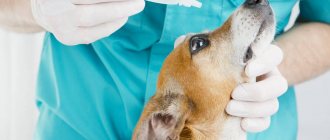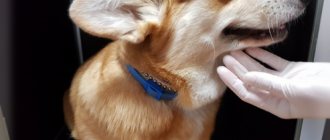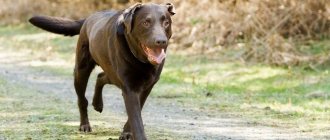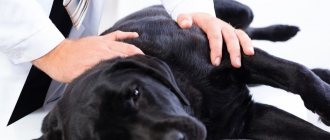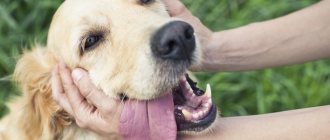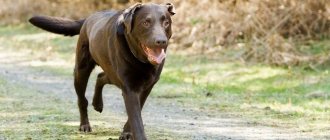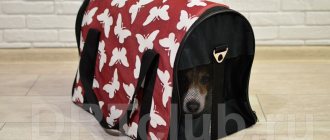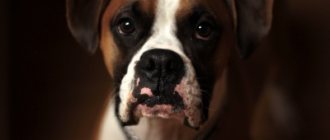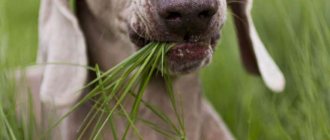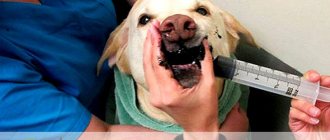You can often see a street dog tuck its paw. At this moment, you involuntarily begin to wonder what if your pet dog starts limping on his paw, be it front or back. In the case when this is a domestic dog, then almost immediately the owner begins to get nervous and panic, linking his sense of responsibility with what happened.
However, adequate behavior in such cases requires an objective assessment of the situation and timely examination at a veterinary clinic, and, if necessary, treatment. It is simply impossible to help a pet with your own efforts in some situations due to lack of experience, proper equipment and medications.
What are the reasons for a dog to tuck its paw?
It would seem that it’s just that the dog begins to tuck its paw or tail from time to time. However, this phenomenon can become an alarm bell for the manifestation of congenital pathologies such as, say, arthrosis. Therefore, let's try to understand the causes of dog lameness. First of all, it is worth excluding the most banal reasons:
- inspect the paw for the absence of any sharp objects or splinters;
- in addition, it is worth remembering whether there have been any sudden movements on the part of the pet recently in order to exclude a sprain;
- There are also more dangerous versions of events - the likelihood of the puppy developing rickets.
In most cases, hind legs become lame due to problems related to the spine, for example, a herniated disc. The secondary symptoms of this disease are:
- constant whining of the dog due to severe pain.
- unnatural arching of the back.
- Dog breeds with a fairly long body are most susceptible to this problem.
In addition, paralysis of the dog’s limbs is possible, which is perceived as a symptom of an extremely dangerous infectious disease, colloquially referred to as “distemper”, and in the scientific community as canine distemper. This disease is characterized primarily by unpredictability. It is impossible not to notice that it is extremely contagious, and treatment is quite labor-intensive. There is a real risk for the dog to remain paralyzed for life, even death.
Diagnosis of the disease
To determine the exact cause that led to a change in motor activity, raising the hind limb and pain, specialists at a veterinary clinic in Moscow carry out a comprehensive diagnosis. It includes a visual inspection and additional research.
Clinically, the veterinarian evaluates the degree and characteristics of lameness in the animal, muscle mass in the hip joint, as well as its mobility. Instrumental methods used to diagnose Legg-Calvé-Perthes disease include tomography, arthroscopy and ultrasound.
Differential diagnosis is used to exclude diseases with a similar clinical picture (for example, hip dysplasia or patellar luxation). The results obtained are used for further development of the treatment program.
What is the essence of this process
If we understand the issue in more detail, we can draw the following conclusions. Often the dog begins to press his paw when the claw is broken. These situations cannot be called rare, but they are extremely painful for the dog. A broken claw needs to be removed with anesthesia. If bleeding occurs, apply a tight bandage; if possible, burn it out or resort to medications to stop the bleeding.
Immediately after the claw is removed, the rehabilitation process will begin, which can take from several months to a year for full recovery. Depending on the complexity of the wound, you can use antibiotics.
In addition, there is a possibility that a foreign object has stuck between the toes or into the pad of the paw. To relieve your dog of pain, you will need to carefully remove it using tweezers. As a rule, such objects are small pebbles, glass shards, twigs, etc. Rarely, however, excess hair can create discomfort in movement, therefore, the best option would be to get rid of it.
Dry paws are certainly accompanied by cracking of the dog’s paw pads, which affects the discomfort of the four-legged dog, causing him to tighten his paws. In this case, moisturizing creams will become a solution to the problem. You can resort to lotions, including those used for human hands. The moisturizing procedure should be followed for several days.
True, there is no need to be fanatical about solving the problem, because otherwise (excessive softness of the pad) will significantly increase the risk of injury. We can give you a little advice: after applying a layer of cream or lotion, put on a sock or special boot to prevent your pet from licking the layer.
The answer to the interesting question of why a dog tucks its back paw in some situations can be simple negligence on the part of the owner himself. The animal should not move on difficult, hard, rocky surfaces. If you cannot prevent movement in such locations, then it is advisable to wear special boots.
How puppies develop from birth to 2 months
In the first days, newborns rely on smells and tactile sensations. Even being blind, they have no problem finding their mother's breast and are drawn to the warmth of her body. Thanks to active development, by 2 months four-legged pets become completely independent.
IMPORTANT!
Socialization is important for any animal, but do not rush to introduce kids to other people and animals before vaccinations. Otherwise, they risk contracting an infection.
When your eyes open
Dogs are born not only blind, but also deaf. Hearing appears after 7 days, and vision appears a little later - after 10-14 days. At first, babies only have access to very loud sounds and a blurry picture of the world. By 1-2 months, hearing and vision are completely normalized, acquiring the maximum available sharpness and clarity.
When they learn to walk
The first motor activity is observed soon after the opening of the eyes. At this age, babies begin to make their first attempts to stand on their paws. It is important to understand that before 2 weeks it is difficult for them to maintain their weight, so you should not be surprised by the funny movement on their bellies.
When teeth appear
Milk teeth erupt at 1-1.5 months. At this age, animals are given their first complementary foods, consisting of ground natural products, ready-made meat pates or soaked dry food.
IMPORTANT!
Molar teeth erupt immediately after milk teeth, that is, already at 3 months. A change in dentition is often accompanied by stomatitis, so be careful and monitor the condition of the oral mucosa.
The problem of paw squeezing
You can often see situations where an animal begins to limp, seemingly for no objective reason. At such a moment, natural sympathy and a lightning-fast desire to help the pet solve this problem arise. However, it is worth remembering that without appropriate education and treatment experience, or special diagnostic equipment, it will not be possible to establish the reason why the dog presses its front paw. The surest way out in such a situation would be to contact a professional – a veterinarian.
Experts have been repeating to clients for many years that as soon as a four-legged animal begins to tuck in its limbs, lacks a clear line of its hind legs, eats poorly or refuses to eat at all, whines, trembles, and is unable to stay in place, an immediate visit to a veterinarian should be made.
It is enough to identify the problem on your own, and for the rest, rely on professionals
- It is highly likely that the dog is developing infectious arthritis accompanied by a tumor. You can't do without seeing a doctor.
- In the case when an animal limps after sleep, and after some time, as they say, “saunters” and returns to normal, we can judge with a high degree of confidence that this is a dislocated shoulder. Again, you won’t be able to determine the cause yourself. Most likely, an x-ray will be required here. It happens that the dog begins to limp after the injection, which indicates that the procedure was carried out incorrectly or the occurrence of painful sensations. These symptoms will pass over time, after which the pet will forget about the lameness.
- Sometimes a pet limps after a walk: it’s a good idea to check the dog’s paws. There is a risk that foreign objects have gotten into them or a claw has broken off. If you have to talk about a foreign object, then, if possible, you can try to get rid of it yourself. Removal of a broken claw is carried out by a veterinarian.
- It is not uncommon for a dog to be attacked by ticks, which then leads to infectious diseases. The course of the disease is accompanied by fever, swelling of the joints and lameness. In this case, you cannot do without the help of a specialist.
- With the periodic appearance of lameness and without the presence of all the above symptoms, it is most likely osteochondrosis.
When does the puppy begin to lift his leg to take a “little walk”?
Even people far from the animal world know that dogs do their “little” things in different ways. The males busily raise their legs, and the females sit down. We think all our readers will be interested to know that “boys” acquire this model of behavior and do not absorb it with their mother’s milk. It is enough to look at how little puppies behave to be convinced of the correctness of these words. And suddenly, at one fine moment, the owner notices that his pet has matured and is doing his business in a completely “grown-up” way.
Why do male dogs do this?
The explanation is quite simple. The dog doesn’t just urinate, but leaves a bunch of useful personal information for its relatives: it reports gender, age, activity level, and its territorial claims. Male dogs, when removing their paws, irrigate a much larger area with urine compared to if they simply sat down.
Dogs love to read their “social media”.
Each dog (of any gender), having received a mark, draws its own conclusions. Even castrated dogs raise their paws. True, they still do not set the goal of attracting beautiful ladies; We are talking exclusively about territorial marking. For example, the owner will let his neutered male dog out into the garden. After some time, if you observe, he will definitely put marks around the perimeter - that is, he will mark the boundaries of his territory.
In turn, dogs do not just read the marks left by their relatives. They mark it as “read”: they simply urinate in this area again.
How do puppies learn to lift their paws?
Two ways. The first is that they carefully observe older and more “experienced” dogs. All dogs, it should be noted, are smart and observant; they adopt many behavior patterns by simple copying. The second way is that the dog matures, becomes older, and the call of nature makes itself known. Yesterday's puppy begins to feel the need to leave a mark, and not just leave it furtively, but “sign it in a sweeping manner.” In other words, the puppy suddenly realizes that he needs to spray his urine over as large an area as possible. It is possible that one method overlaps with the second. Be that as it may, growing puppies learn basic dog wisdom very quickly. Especially quickly when there is an experienced mentor nearby - an adult male dog, wise with life experience.
Establishing the cause of paw curling
Canine lameness is diagnosed based on certain fundamentally different clinical signs. Often the disease manifests itself through asymmetry of movements, as well as the inability to step on the paws.
Movement disorders require treatment. True, it is impossible to cope with them without establishing the causes of the disease. Only a specialist can determine the causes of lameness based on the collected anamnestic data. In most situations, additional blood tests will be required to rule out metabolic disorders or external infections causing lameness.
Fractures. Based on the saying: “heals like a dog,” it is generally accepted that pets are quite capable of independently coping with all the consequences of falls or strong blows to the front and back line of the paws. In real life, the limb swells, which leads to lameness and illness. The four-legged animal begins to whine and show aggression.
Muscle strain occurs due to intense physical activity. The limb swells and pain occurs when supination occurs. This phenomenon can be observed in puppies in case of unsuccessful jumps.
The manifestation of myositis in a pet is quite unpleasant. Prolonged physical activity involves the accumulation of lactic acid in muscle tissue in large quantities. This, in turn, causes severe unpleasant pain. It is also interesting that weakness appears after rest, while movement reduces pain.
Treatment methods
Approximate treatment plan
Fracture
Surgery to place pins and plates to help the bone heal properly. After a month, the dog gets up on its paws and begins to lead an active life.
In case of damage to the peripheral nerves of the spinal column
Drugs are prescribed to stimulate the restoration of nerve tissue. As a rule, treatment takes a long time due to the nature of fiber regeneration.
Tumors and intervertebral hernia
Depending on the size of the pathology, surgery is performed.
Osteochondrosis
Successfully treated at different stages. Therapy is complex and lifelong.
Appointed:
- Dietary therapy to maintain healthy joints from a line of professional animal feeds
- Chondroprotectors – for restoration of cartilage tissue
- B vitamins - as a rule, the drug Combilipen is used
- Nonsteroidal anti-inflammatory drugs
- Physiotherapeutic procedures - warming with a blue lamp
- Massage if the disease was detected at an early stage.
Treatment is long and complex and always comprehensive
Spondylosis
It is treated with lifelong use of NSAIDs and various methods of physical therapy, for example, acupuncture at certain points and acupressure. In case of calcification of the ligaments, lipase injections are prescribed.
Discopathy
In the early stages, NSAIDs are used. In advanced cases, surgical intervention.
What to do?
It is worth noting that in the absence of practical experience, you should not even try to solve the problem on your own when a dog presses its back paw. If we talk about the potential discovery of a splinter or glass in the paw, then it is possible to deal with it with your own efforts, taking into account preliminary disinfection of the wound. In the future, an appeal to a specialist will follow in order to rid the animal of the foreign body without consequences.
If you fall, there is always the possibility of injury or sprain. An accurate diagnosis will require x-rays. If an injury is confirmed, a full examination cannot be avoided. To exclude congenital and hereditary pathologies, information about the pedigree of the animal is required. In this case, it is worth familiarizing yourself with information about the pet from its history or talking with the puppy’s breeder.
To avoid the onset of a dangerous disease such as distemper, it is better not to self-medicate, completely trusting the veterinarian, who will be able to timely diagnose the problem and prescribe a course of treatment. This is how you can understand the question of why a dog presses its back paw. Take care of your little friends. Only the right actions will allow your pet to return all the beauty of normal movement, and, in some cases, even save a life. And remember that you are responsible for the tamed animal.
Currently reading:
- What does it mean if a dog begins to tuck its tail?
- We teach the dog the correct command give paw
- Causes of lameness on the front or hind legs of a dog
- Games to choose for training a dog
What causes necrosis of the femoral head?
The exact cause that leads to Perthes disease in dogs is unknown. It is believed that necrosis of the femoral head is a genetic disease, but recently veterinarians have come to the conclusion that the lesion is influenced by sex hormones. Other factors associated with hip injury in dogs weighing up to 12 kg include overuse due to muscle weakness.
On a note! When examining animals suffering from Legg-Calvé-Perthes disease, symptoms of hypothyroidism and pituitary dwarfism (dwarfism) are often detected.
How to treat?
It all depends on the cause of the symptom. In mild cases, if the dog gets a sharp pebble or wood chip between the pads, the owner removes them himself. Cuts, deep splinters or damage to the claw require the intervention of a veterinarian; sometimes the wound has to be sutured and the claw completely removed and bandaged.
Diseases require a complete examination of the dog, diagnosis; treatment can only be prescribed by a veterinarian, based on the clinical picture of the identified pathology.

